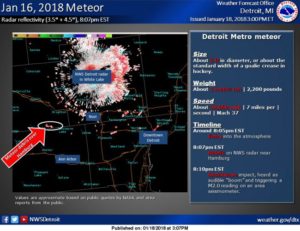
Marquette, Michigan – Observed by hundreds of witnesses and reported by NASA, “A bright fireball lit up skies over Michigan at 8:08 p.m. EST on Jan. 16, an event that was witnessed and reported by hundreds of observers, many who captured video of the bright flash.”
NASA blogs confirm much that was reported. “Based on the latest data, the extremely bright streak of light in the sky was caused by a six-foot-wide space rock — a small asteroid. It entered Earth’s atmosphere somewhere over southeast Michigan at an estimated 36,000 mph and exploded in the sky with the force of about 10 tons of TNT. The blast wave felt at ground level was equivalent to a 2.0 magnitude earthquake.”
Shortly after the event, the University of Michigan offered media outlets access to experts talk about and interview on the subject. The 8th Day was fortunate enough to interview Professor Michael Liemohn to talk in depth about the event and other space hazards.
The University of Michigan Press Release describe Dr. Michael Liemohn of the University of Michigan, “professor in the Department of Climate and Space Sciences and Engineering, is an expert on space hazards. He saw the meteor from his car and recognized it as a “bolide,” a small meteor that explodes and burns up in the sky before reaching the ground. On the 8th Day Radio show he discussed space hazards in general, asteroid detection, and a relatively recent incident in Siberia in which the sonic boom from a bolide caused property damage and injuries.”
Prior to his interview, additional quotes from Professor Liemohn on the event were provided. “This was probably a rock of only a few feet in diameter,” he said. “The primary way that a bolide can be dangerous is broken glass. Weird, but true. They are moving at thousands of miles per hour through the atmosphere, so, supersonic speeds, and they create a sonic boom that can reach the ground. If this bolide had been a slightly bigger rock, then it could have broken windows. A bolide that exploded over Siberia a few years ago, which was a roughly 10-ton rock—about the size of the University of Michigan ‘rock’ at Hill and Washtenaw—sent roughly 1,000 people to the hospital, some with broken bones from falling over but most from broken glass as windows exploded inward.
“Dark-colored space rocks, aka asteroids, of this size are essentially invisible against the blackness of outer space. We can often detect the really big ones, house-sized or bigger, but boulder-sized are just too small to see until they are very close to Earth. Even then, we have to be looking in just the right direction. NASA’s Planetary Defense Program is designed to identify and deflect larger rocks. If they predict that there is a good chance it might our planet, then NASA has several options to deflect the path of the asteroid, like hitting it with a missile or shooting it with lasers.”

Two other professors from the University of Michigan were also asked to talk on the 8th Day, but due to scheduling conflicts they could not appear on the show, but their comments were made available:
Ted Bergin, professor and chair of the Department of Astronomy, uses chemistry to probe the physics of star and planet formation and to trace the molecular origins of life. “These rocks are the leftovers of planet formation—they never made it into a planet like our own,” he said. “Because of that, they contain inside them the history of our own origins and can tell us how a planet like our own was born.
“Meteorites fall from the sky every day. Most of them are so small they burn up in the upper atmosphere and don’t reach the ground. However, in some cases they are large enough to penetrate deeper into the atmosphere where they either explode before hitting the ground or reach the ground itself. These bodies are on the order of meter-sized or larger. The frequency that they impact the atmosphere is in terms of one every 3 to 10 years. Recall that most of the Earth’s surface is covered by water—so there is a greater chance of this hitting the ocean. So we have no particular worry or concern—but it does happen and can be spectacular.”
David Gerdes, professor in the departments of Physics and Astronomy, studies the structure and evolution of the universe. “The Earth is hit by meteors all the time—about 1,000 visible meteors reach the Earth’s atmosphere every second. Most of these are no bigger than a grain of sand.
“Meteors that penetrate deep enough into our atmosphere to produce the large visible and audible burst like we experienced last night come from object with diameters of about one meter or more, and are more rare. Experts estimate that a 1-meter sized object hits us every few months, a 10-meter sized object (like the one that appeared over Russia in 2013, causing injuries and significant property damage) happen every few years to decades, and a 100-meter sized object every few thousand years.
Additional comments were provided by Larry Ruff, professor in the Department of Earth and Environmental Sciences, a seismologist who oversees the Ann Arbor seismic station, which is on the U-M campus. He said the Ann Arbor seismograph recorded the event and that it produced a strong and unusual seismic signature.
“This was an explosion in the atmosphere, not an earthquake, and it produced a seismogram that is very different from what you get from a small, regional earthquake,” he said. “Seismologists who are experienced enough can tell that it’s not an earthquake because the character is very different.”
As reported by the University of Michigan, Ruff has worked at the U-M seismic station since 1982 and said he has never seen such a strong signal recorded there following an atmospheric event. “In some of the previous notable sonic booms and meteor explosions, I looked and never saw a signal like this,” he said. “This one just stands out. This is the strongest signal—the best seismogram—of all the ones I’ve seen over the years at the Ann Arbor station.”

Additional Information provided by the official NASA’s Marshall Space Flight Center blog:
- Events this size aren’t much of a concern. For comparison, the blast caused by an asteroid estimated to be around 65 feet across entering over Chelyabinsk, Russia, was equivalent to an explosion of about 500,000 tons of TNT and shattered windows in six towns and cities in 2013. Meteorites produced by fireballs like this have been known to damage house roofs and cars, but there has never been an instance of someone being killed by a falling meteorite in recorded history.
- The Earth intercepts around 100 tons of meteoritic material each day, the vast majority are tiny particles a millimeter in diameter or smaller. These particles produce meteors are that are too faint to be seen in the daylight and often go unnoticed at night. Events like the one over Michigan are caused by a much rarer, meter-sized object. About 10 of these are seen over North America per year, and they often produce meteorites.
- There are more than 400 eyewitness reports of the Jan. 16 meteor, primarily coming from Michigan. Reports also came from people in nearby states and Ontario, Canada, according to the American Meteor Society. Based on these accounts, we know that the fireball started about 60 miles above Highway 23 north of Brighton and travelled a little north of west towards Howell, breaking apart at an altitude of 15 miles. Doppler weather radar picked up the fragments as they fell through the lower parts of the atmosphere, landing in the fields between the township of Hamburg and Lakeland. One of the unusual things about this meteor is that it followed a nearly straight-down trajectory, with the entry angle being just 21 degrees off vertical. Normally, meteors follow a much more shallow trajectory and have a longer ground track as a result.
Link – Additional History of Michigan Meteors – pdf file











